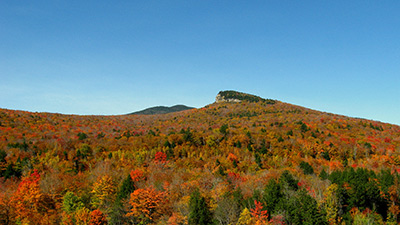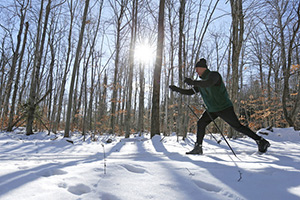
Bob Perschel could be described as an activist, a forester and a leader in his field, but what stands out most about him is his passion for the mission. Brought on as executive director of the New England Forestry Foundation (NEFF) in early 2012, Perschel wasted no time in putting in motion a landmark report that not only describes a remarkable vision for sustainability as it relates to forests — calling for New England to preserve 30 million acres by 2060 — but also charts a course to achieve it. The report marks a culmination of the decades that Perschel has worked as a new breed of forester, one who helped shape a ground-breaking manifesto of land ethics to prescribe a different kind of relationship with forests — a relationship in which the forests are valued for their inherent worth apart from human needs.
It’s an idea that stretches back to Perschel’s time with the Forest Guild, of which he was a founding member. “Our belief was that the forests have intrinsic value — that it’s not all about us humans. And that was a switch. The guild set out the concept that if you’re an employee of someone that is asking you to do what you think is the wrong thing to the forest, your obligation is to the forest and you should disassociate from the employer. In the profession it’s very controversial. We took a stand. We work for the forest.”

But as devoted as he is to the forest, Perschel’s path to this work wasn’t a straight one. After graduating from Yale with a bachelor’s degree in psychology, he got a job at IBM, figuring he would work for a while, save some money, then go to law or business school. But along the way, he got the suspicion that his path in life wasn’t meant to follow that particular trail. He says, “I went out to sit under a tree and thought — now what do you really want to do? This is where I want to be, out here, but — how do you do that?” It was then that he made a turn. He decided to go back to school — Yale School of Forestry.
“I didn’t go there to be a forester,” says Perschel. “I had other ideas — like be an environmental planner. But I started taking forestry courses and that’s when it hit me that this is a natural system that’s intact, that also yields benefits for people. And we can help people know how to best manage it — keep it intact and also get the benefits. That’s what really hooked me.”
And many would say the forestry industry in New England is lucky he was hooked. “We needed a spark plug for the board and fellow staff,” says Tim Ingraham, president of the board. “And that has been Bob.”
With Perschel at the helm, NEFF’s vision is to keep forests as forests, accessible to the public and an active training ground for foresters learning to optimize forest yields for wood products. But there are obstacles to getting all those forests into conservation, and particularly, in actively managing them for lumber.

“The public has a problem with harvesting trees and the prospect of increasing the harvesting of trees,” says Perschel. “That’s our audience, the people who are environmentally sensitive but don’t really understand how forests fit into the equation of sustainability and what it means to their lives. The person who doesn’t want to see a tree cut but has a wooden table or floors.”
Part of working for the forest is communicating about the forest, and NEFF chooses to do that by cataloguing the benefits of trees to health, recreation and the economy. If managed as outlined in Perschel’s NEFF plan, in addition to ancillary benefits like preserving wildlife habitat, the forests will directly contribute at least $5 billion to the region’s economy each year. On top of that are the indirect benefits: improving air quality, thus reducing health care costs and crop damage that could otherwise top $700 million each year; purifying rainwater naturally, saving up to $6 billion otherwise needed to produce clean water; keeping 3.5 million metric tons of carbon out of the atmosphere by using 400 million board feet of local wood for building, as opposed to steel and concrete.
One of the central assertions is that some of the products we get out of the forest are actually better than the other alternatives that we’re using. “Our assumption is that you, our audience, wants to be sustainable, and we show you how regional forests and wood products can help you lead a sustainable life. We can’t demand the products and have them imported from someplace that we don’t know, or instead of making the table out of wood, make it out of steel and never think about the impact on the environment,” says Perschel.
“The best choice, we think people will agree, is to do it in our region, on your watch, sustainably under your eyes, with your input. You’ll have some assurance that it is better than the alternatives.”
Lea Sloan writes from Washington, D.C. and is American Forests’ vice president of communications.